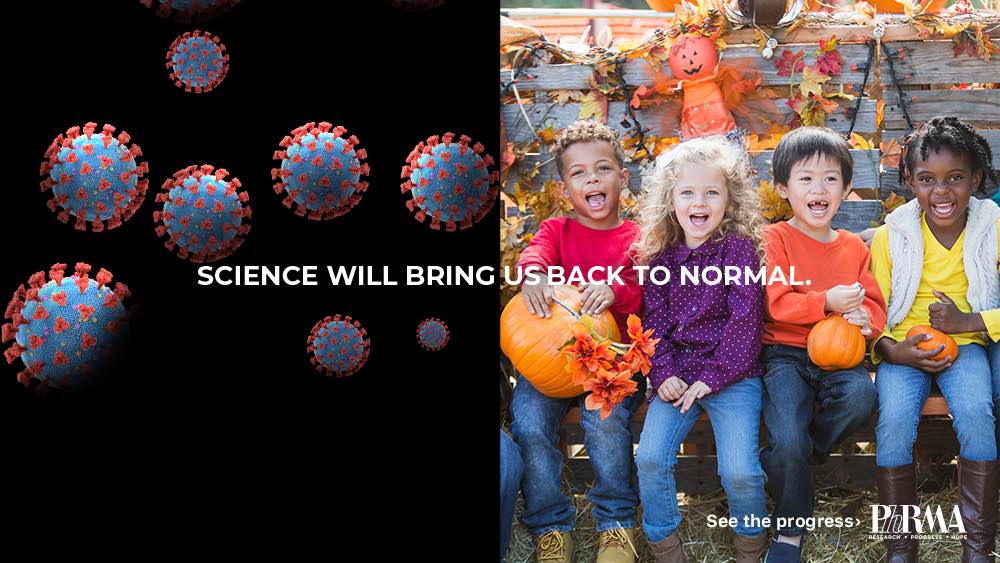| | | | | | | Presented By PhRMA | | | | Vitals | | By Caitlin Owens ·Oct 22, 2020 | | Good morning. Situational awareness: An advisory committee of outside experts meets for the first time today to consider coronavirus vaccines, a sign that the Food and Drug Administration is following its usual science-based process. Today's word count is 963, or a 4-minute read. | | | | | | 1 big thing: The pandemic is getting worse again |  Data: The COVID Tracking Project, state health departments; Note: Due to a database error, Missouri had a 3 day gap in reporting from Oct. 11-13; Map: Andrew Witherspoon/Axios Every available piece of data proves it: The coronavirus pandemic is getting worse again, all across America. The big picture: As the death toll ticks past 212,000, at a moment when containing the virus ought to be easier and more urgent than ever, we are instead giving it a bigger foothold to grow from, Axios' Sam Baker and Andrew Witherspoon report. - And that's even before we head into winter, when the risk of cases and deaths is expected to grow as everyone huddles indoors in closed spaces.
Where it stands: The U.S. is now averaging about 59,000 new infections per day — the most since early August. New cases were up by about 15% over the past week. - That's the sixth straight week of increases, following a brief improvement after the summer's surge in cases.
- Hospitalizations are up, too. There are about 39,000 people in the hospital today for COVID-19, also the most since early August.
- In 16 states, the share of hospital beds occupied by COVID patients is as high right now as it's been at any point in the pandemic.
One piece of good news: The death rate from the virus is the one thing that isn't going up. - Patients who are in the hospital for the coronavirus — those with the most severe infections — have about a 7.6% chance of dying, according to new research. That's a significant improvement from the early days of the pandemic.
What's next: A vaccine will be a momentous, life-saving step forward, but it won't be the knockout blow many Americans are hoping for. It probably won't stop the virus from spreading altogether, and only a handful of people will be able to get it. And experts have every reason to believe things will get worse in the meantime. Go deeper. |     | | | | | | 2. Many U.S. coronavirus deaths were avoidable |  Data: National Center for Disaster Preparedness; Chart: Sara Wise/Axios Here's another way to think about the U.S. death rate: If it had matched that of other wealthy countries, between about 55,o00 and 215,000 Americans would still be alive, according to a scathing new analysis by Columbia University's National Center for Disaster Preparedness. Why it matters: These countries have taken a significantly different approach to the virus than the U.S., providing yet another example that things didn't have to be this way. - "Had the U.S. government implemented an 'averaged' approach that mirrored these countries ... a minimum of 130,000 COVID-19 deaths might have been avoidable given alternate policies, implementation, and leadership," the authors write.
- "This discrepancy, which continues to grow daily, provides objective crude measure for assessing the government response to this unprecedented health emergency."
Between the lines: The analysis points to several factors that set the U.S. response apart from other countries', including insufficient testing and contact tracing, a delayed initial response, the lack of a national mask mandate or guidance, politicization and the "failure of top officials to model best practices." - "Particularly, it is the inability or unwillingness of U.S. officials to adapt or improve the federal response over the course of the pandemic that has strongly contributed to the nation's uniquely high COVID-19 fatality rate," the authors conclude.
|     | | | | | | 3. Boston and Chicago send students back home |  | | | Illustration: Annelise Capossela/Axios | | | | Large school districts that were in a hybrid reopening phase reverted back to virtual learning in response to growing community spread of the coronavirus, Axios' Marisa Fernandez reports. Driving the news: Both Boston and Chicago's public school districts closed for in-person learning as health officials investigate what caused the spikes in nearby suburbs. - San Francisco public school officials decided Wednesday not to bring students back into the classroom before the end of the calendar year, in part due to limited coronavirus testing capacity.
Why it matters: The nation's largest school systems went virtual this fall, and are juggling a slew of social, economic, health and political factors when it comes to resuming classes for in-person learning — and keeping them open. - Early data collected on smaller school districts shows schools so far have not contributed to community transmission.
The other side: New York Gov. Andrew Cuomo released updated maps Wednesday that clear 120 schools in New York City to reopen of 169 that were initially closed, Chalkbeat reports. |     | | | | | | A message from PhRMA | | Biopharma is progressing in the fight to beat COVID-19 | | |  | | | | Biopharmaceutical companies across the country are collaborating in new ways to help defeat the coronavirus. The results: In a matter of weeks they've gone from potential treatments to antibodies and antivirals that have shown positive results. See how science can help us get back to normal. | | | | | | 4. CDC expands definition of "close contact" | | The Center for Disease Control and Prevention expanded its definition of who is considered a "close contact" of an individual infected with the coronavirus in a report released Wednesday, Axios' Shawna Chen reports. Why it matters: The update is likely to pose challenges for schools, workplaces and other group settings as the U.S. prepares for a third coronavirus wave. - It also reinforces the importance of masks in the face of President Trump's repeated attempts to belittle their efficacy.
Where it stands: The CDC now defines a "close contact" as someone who has been within six feet of an infected person for 15 minutes or more across a 24-hour period. The guidance was previously described as someone who spends more than 15 consecutive minutes within six feet of an infected individual. - The change has significant implications, making contact tracing more difficult and requiring rigorous adherence to social distancing guidelines.
- It could also lead to a jump in confirmed cases due to increased testing.
The state of play: The change came about due to a COVID-19 case that developed following multiple brief exposures in a Vermont correctional facility over the summer. |     | | | | | | 5. Catch up quick |  | | | Illustration: Aïda Amer/Axios | | | | Senate Democrats on Wednesday blocked a vote on Republicans' $500 billion targeted COVID-19 relief bill, a far less comprehensive package than the $1.8 trillion+ deal being negotiated between the Trump administration and House Democrats. New York reported over 2,000 positive coronavirus cases on Wednesday — the most infections seen in the state since May, per COVID Tracking Project and health department data. Boeing and researchers at the University of Arizona say their experiment with a live virus on an unoccupied airplane proves that the cleaning methods currently used by airlines are effective in destroying the virus that causes COVID-19. Many of the digital jobs of the future have suffered during the later stages of the pandemic, while in-person health care jobs are on the rise, Axios' Bryan Walsh reports. Spain exceeded 1 million confirmed coronavirus cases on Wednesday, becoming the first country in Western Europe to hit the milestone, according to data from Johns Hopkins University. |     | | | | | | A message from PhRMA | | The biopharma industry commits to defeat COVID-19 | | |  | | | | America's biopharmaceutical companies have the goal to defeat the coronavirus. What this means: The biopharma industry is working closely together and collaborating in unprecedented ways to speed up the development of a vaccine and treatments. Watch the video. | | | | | | Axios thanks our partners for supporting our newsletters.
Sponsorship has no influence on editorial content. Axios, 3100 Clarendon Blvd, Suite 1300, Arlington VA 22201 | | | You received this email because you signed up for newsletters from Axios.
Change your preferences or unsubscribe here. | | | Was this email forwarded to you?
Sign up now to get Axios in your inbox. | | | | Follow Axios on social media:    | | | | | |








No comments:
Post a Comment